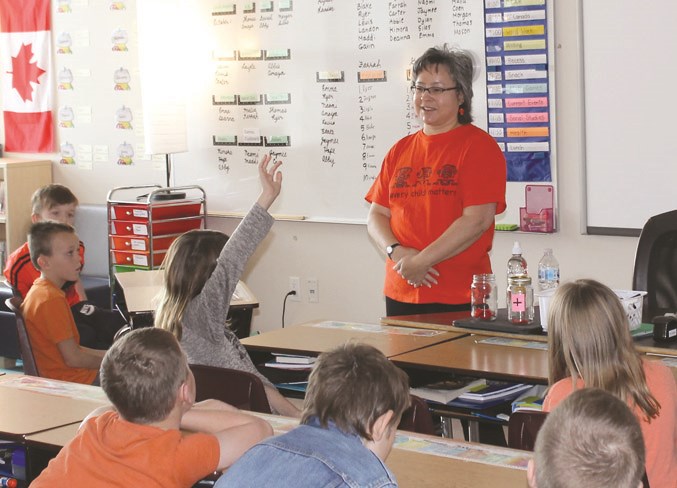When Phyllis Webstad was six-years-old and about to start school, her aunt took her shopping for some nice clothes to wear on her first day.
Deciding on a bright orange shirt, Webstad wore her new clothes with pride as she attended school at the St. Joseph Mission near Williams Lake, BC.
Unfortunately, the staff at the residential school had different ideas. Upon arriving, Webstad was forced to change into a school uniform and her clothes were taken away. She never saw her orange shirt again.
“It was a ‘Finding Nemo orange,’ very shiny and had three button holes down the front and had a lace through it,” she said. “But when I got to the residential school, my clothes were taken away. I don’t remember wearing them again.”
The experience stayed with her for her whole life. Now 51-years-old, Webstad has spent the last month on tour discussing her book, The Orange Shirt Story, describing her experience and educating young Canadians about what First Nations and Metis people in Canada were subjected to over the last century.
Her tour has taken her from the coast of B.C. all the way to Pembina North Community School and Busby School on Oct. 15 and back again. She explained the book was a part of the challenge issued during the Truth and Reconciliation Commission, which wrapped up hearings in 2013.
“I wanted to visit everyone who participated in Orange Shirt Day,” said Webstad. “I’m a third generation residential school survivor. My granny attended for 10 years, all of her children attended for 10 years, myself and my son also attended the last residential school in Saskatchewan.
“The people that did this to us will never go to jail. Seeing kids wear orange is a little bit of justice for survivors in our lifetime.”
Part of the inspiration, she noted, was teachers and counsellors trying to explain to kids what Orange Shirt Day is about and why it is important. Providing a first-hand account of how her own life was shaped by the residential school system gives teachers a tool to explain the importance of reconciliation.
It also served as a form of therapy for Webstad as she comes to terms with her pain.
“Life can be understood backwards, but it must be lived forwards,” she said. “After I go through my speech, I always call my spirit back to today. I can go there, I can talk about it, cry and re-live it, but I must come back to today.”
Webstad said the reception from the children she’s visited has been overwhelming.
“Everywhere I go I’m getting hugs from children. Some even want my autograph,” she laughed. “Sign their water bottles, sign their books. When I speak to fellow survivors now, I assure them that our world is in good hands. This generation coming up has empathy, they understand and they will make sure that this doesn’t happen to anyone ever again.”
PNCS principal Raime Drake said students were very happy to see Webstad and the lesson was a powerful one for the Grades 1 to 6 classes.
“We had a whole school assembly and then she went and did a Q&A in each of the Grade 4, 5 and 6 rooms,” she said. “We all wore our orange shirts to show our support. It’s a symbol for something bigger, but we got to hear about her experiences first-hand. It really aligns with our inclusive philosophy that every child matters and every child belongs. There’s lots of different cultures and lots of different needs, but everybody gets to participate in school.”
As for Webstad, publishing her first book has whet her appetite. She says she’s brainstorming ideas for follow up stories intended to communicate to children of varying ages.
“I have some ideas, I’m thinking of writing a book for older grades relating to my story,” she said. “I also want to do a book on stories from the land for the kids, stories on fishing, berry-picking — just funny things that happened in my family. But right now I just need to make it to Christmas, then I’ll think about what’s happening next.”



